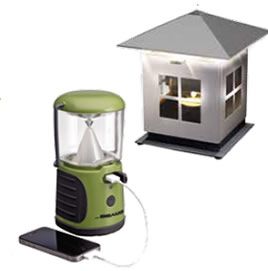Photos courtesy of manufacturers

Enjoying summer nights outdoors with friends got us thinking about options for lighting up the cockpit during the seasons easy evening hours. We found two innovative products that piqued our interests-the Mr. Beams wireless LED lantern and Thermologis JOI candle lantern, which uses thermoelectric energy to produce electrical power from heat-and one do-it-yourself solution using a water bottle.
JOI Lantern
When we first saw the JOI lantern, we were fascinated. The lantern uses the heat produced from a single tea candle to light eight, tiny LEDs on the roof of the small, stainless-steel housing. The LEDs light reflects off the housing, and the primary and reflecting light cast a soft, glowing light in all directions.
The stainless-steel lantern measures 6 inches wide by 6 inches deep by 8 inches tall, and it weighs a hefty 5 pounds. Instead of using batteries or wires, the JOIs illumination is the result of thermoelectric energy. Its operation is based on the Seebeck effect, which is the conversion of temperature differences into electricity.
When Thermologis Canadian parent company Caframo sent us a JOI lantern to try out, we werent sure what-if any-practical use the product would have on a sailboat. One of the most obvious deficiencies was its lack of a hanging ring, and of course, the challenge of lighting a candle in the cockpit. However, we were interested in how it works.
The JOI works when a small metal wafer inside the lamp has one hot side, which is heated by a tea-light candle, and one cold side, which is kept cool by a heat zinc. The difference in these temperatures creates a DC current, which is then used to power the LEDs.
The Seebeck effect was developed in 1821, and Caframo has been using thermoelectric energy applications in its products for 20 years. Because the heat transfer doesn’t create a lot of power, uses with incandescent bulbs (which require a lot of power) were not successful. LED lights, which require very little power, were a natural match for lights using the Seebeck effect.
Caframo recommends using a four-hour tea candle to power the lantern. Smaller candles lack the heat required for full efficiency, and eight-hour candles tend to be too tall, causing the flame to brush against the metal housing, creating soot build-up. The four-hour candles provide 70 lumens of light, enough to read by; by comparison, effective LED reading-light bulbs have outputs that can range from 35 to 170 lumens (see PS January 2009 online).
Bottom line: Well constructed, the JOI lantern comes with a one-year warranty. Besides its steep $150 price tag, our main concern with the JOI is whether it will withstand the rigors of the marine environment. Were field testing it, so stay tuned for followup reports.
While its certainly not a must-have, its a cool light for those who don’t mind the price tag or stocking tea candles, and for who are looking for unique lighting for cocktails in the cockpit, dinner on the dock, or cozy cabin ambience. We don’t recommend it for cabin lighting.
For testers, the highlight of the JOI is the fact that it combines technology developed in the 1800s with the latest in lighting tech: LEDs. We are intrigued by the potential of its centuries-old technology put to use in todays products. Imagine if the kerosene lanterns of yesteryear, like those still sold by Weems & Plath, could provide LED illumination in addition to the incandescent light from the wick.
Mr. Beams LED Lantern
The wireless LED Mr. Beams UltraBright Lantern is powered by four D-cell batteries. The lantern has three LEDs and a specially designed reflector lens that puts out 260 lumens of light, which is comparable to the output of our favorite LED cabin lights (see PS May 2014 online).
The Mr. Beams lantern features two brightness settings, a carrying handle, and a USB port that can be used to power or charge USB electronics like cell phones, MP3 players, and digital tablets. One D-cell battery pack is expected to last for approximately 40 hours of run time. The lanterns rubber seals and heavy plastic construction make it weather and water resistant.
The lantern, which comes in green or white, sells for $40 on the Mr. Beams website and has a one-year warranty. It is made by Wireless Environment, Mr. Beams Ohio-based parent company.
Bottom line: While stocking up on D-cell batteries for an extended cruise may not be practical or cheap, the lantern is a sturdy, affordable choice for cockpit lighting or lighting to-go. Testers like its portability, its 360 degrees of lighting, and that it can easily be hung anywhere by its integral hook.
DIY Cockpit Lighting
Weve read about dozens of homemade or jerry-rigged options for cockpit lighting but one that struck us as dead simple and very portable came from The Boat Galley blog (www.theboatgalley.com).
All you need is a small LED flashlight (see PS December 2007 online) and an empty one-gallon water jug. Simply tie the flashlights lanyard to the jug handle, then let the flashlight hang inside the jug. And voila! The resulting light is warm and soft, but the amount of light put out will depend on the flashlight you use.




































